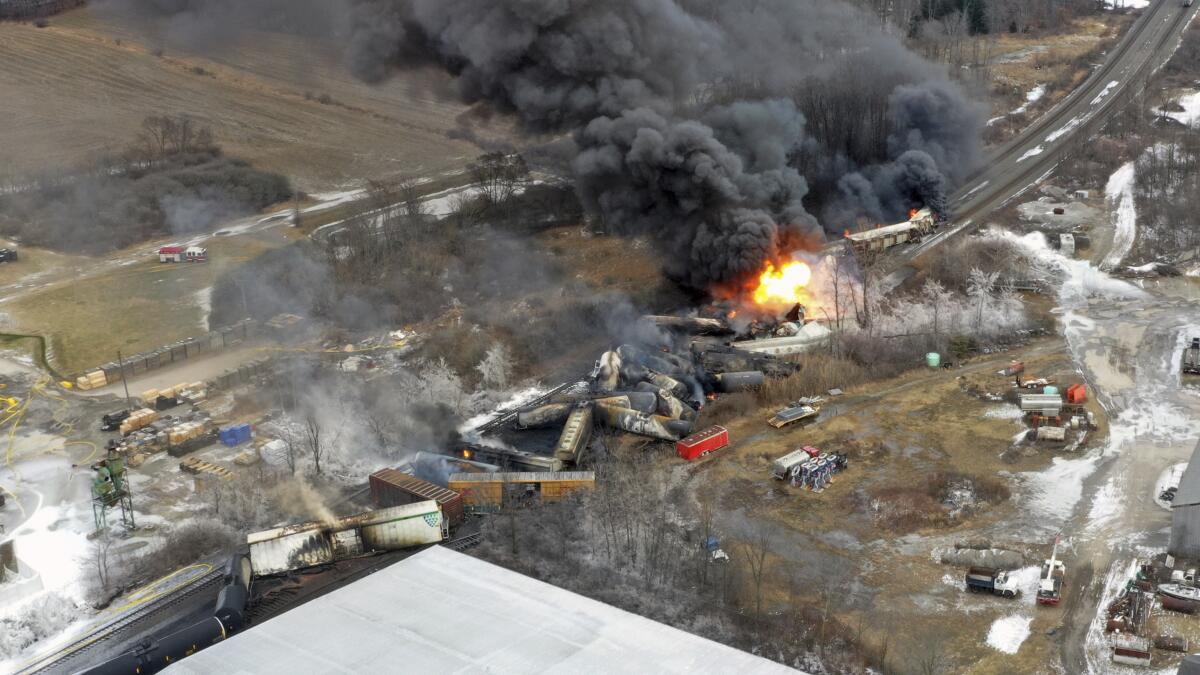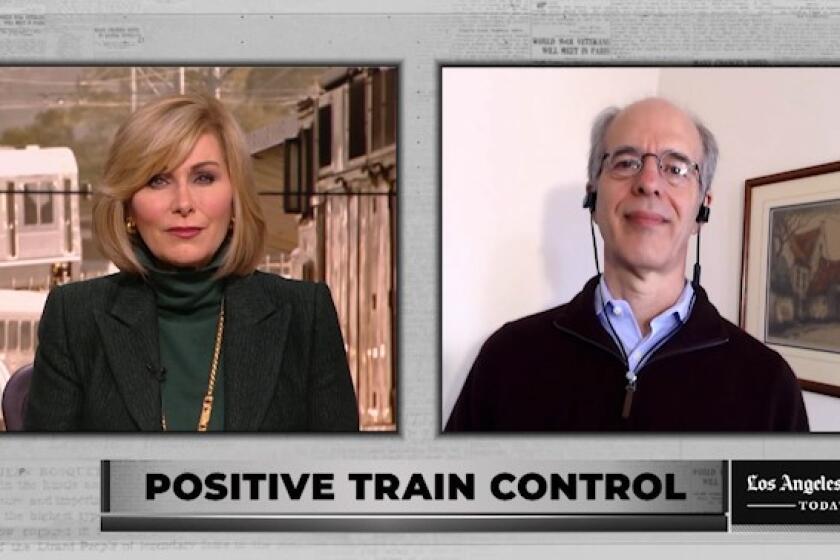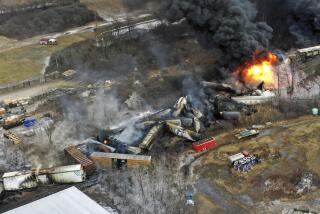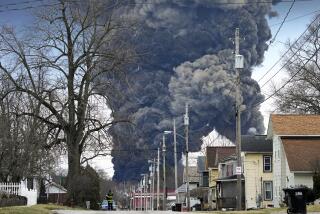Fiery Ohio derailment raises railroad safety questions

- Share via
OMAHA, Neb. — The fiery derailment of a train carrying toxic chemicals — sending a huge plume of smoke in the air and forcing residents of a small Ohio town to evacuate — has highlighted the potentially disastrous consequences of train accidents and raised questions about railroad safety.
The railroad industry is generally regarded as the safest option for most goods and federal data show accidents involving hazardous materials are exceedingly rare. But with rails crossing through the heart of nearly every city and town nationwide, even one hazardous materials accident could be disastrous, especially in a populated area.
Rail unions believe the industry has gotten riskier in recent years after widespread job cuts left workers spread thin.
“It raises all kinds of questions,” Ohio Gov. Mike DeWine told “Fox & Friends” this week when he was asked whether hazardous materials are too dangerous to transport by rail.
“We’ve seen it up close and personal the last few days,” DeWine said. “This is a big, big deal.”
About half of the 4,800 residents in the eastern Ohio town of East Palestine and those in the surrounding area, including parts of Pennsylvania, had to evacuate as officials monitored air and water quality following a controlled burn of chemicals released from damaged tank cars.
The evacuation order was lifted Wednesday after the air was deemed safe.
“ I’m scared to go back home, ” resident Brittany Dailey had said Monday. “I’m eventually going to have to go back, but it makes me want to sell my house and move at this point.”
Ian Jefferies, head of the Assn. of American Railroads trade group, said 99.9% of all hazardous materials shipments reach their destinations safely.
Federal Railroad Administration data showed hazardous chemicals were released during 11 train accidents nationwide last year, out of roughly 535 million miles, with only two injuries reported. In the last decade, releases of hazardous materials peaked at 20 in both 2018 and 2020.
“Railroads are the safest form of moving goods across land in the country without question,” Jefferies said. “But railroads are also working to drive toward zero incidents. Until we reach that goal, we haven’t got to where we want to be.”
Railroads try to route hazardous materials shipments on the safest path. Most of the worst derailments in recent years happened in rural areas, but in 2013 a derailment in Canada killed 47 people in the town of Lac Megantic and caused millions of dollars in damage. A 2005 derailment in Graniteville, S.C., killed nine people and injured more than 250 after toxic chlorine gases were released.
LAC-MEGANTIC, Canada — As firefighters doused still-burning oil tanker cars, more bodies were recovered Sunday in this devastated town in eastern Quebec, raising the death toll to five after a runaway train derailed, igniting explosions and fires that destroyed the downtown district.
Hazardous materials account for about 7% to 8% of the 30 million shipments that railroads deliver across the country every year. But because of the way railroads mix freight together, at least a couple of cars of hazardous materials can be found on nearly any train besides grain or coal trains.
“Railroads are a very safe form of transportation from a standpoint of statistics,” said professor David Clarke, who previously led the Center for Transportation Research at the University of Tennessee. “That doesn’t mean that you’re never going to have an accident. That would be unrealistic for any type of transportation to have zero accidents”
Some say that’s not enough. An East Palestine business owner and two other residents sued the rail operator in federal court on Tuesday, alleging negligence. Among other things, the lawsuit says the railroad failed to maintain and inspect its tracks and rail cars, failed to provide appropriate employee training, and failed to reasonably warn the public.
Greg Regan, president of the AFL-CIO’s Transportation Trades Department coalition, said he worries the chances of a catastrophic derailment are increasing because major freight railroads have eliminated roughly one-third of their workers over the past six years. Companies have shifted to running fewer, longer trains and say they don’t need as many crews, mechanics and locomotives.
Before those operating changes, Regan said inspectors used to have about two minutes to inspect every rail car. Now they only get roughly 30 to 45 seconds to check each car. Signalmen who maintain crossing guards and safety signals along the tracks also have bigger territories, making it harder to keep up with preventative maintenance.
“They’re really just trying to squeeze as much productivity out of these workers as they can,” Regan said. “And when you’re focused on timing and rushing, unfortunately sometimes things can fall through the cracks.”
Government accident data show an uptick in accidents in recent years, although the numbers remain quite small at 8,929 last year. Accidents were tallied at a rate of 17.4 per million train miles in 2019, but that drops to 2.9 accidents per million train miles without incidents at railroad crossings and those involving trespassers that are largely out of railroads’ control.
Regulators at the Federal Railroad Administration say the accident data so far do not show the industry’s new operating model is unsafe. But unions say the new system is risky.
“There isn’t a lot of room for error,” Regan said. “And certainly when you have hazmat on trains all across the country going through communities, we shouldn’t be making any compromises on safety whatsoever.”
Allan Zarembski, who leads the University of Delaware’s Rail Engineering and Safety Program, said railroads are continually working to improve safety and prevent derailments.
Railroads are developing new acoustic detectors being placed along tracks to signal if a bearing is about to fail. Heat sensors also have been in place for years to spot overheating bearings, which is one of the most common causes of an axle failure, Zarembski said.
Federal investigators have said the Norfolk Southern train crew received a warning about a mechanical problem shortly before an axle failed and caused the Ohio derailment.
Railroads and the shipping companies that own tank cars also have been steadily improving them to reduce the chances they will rupture in a derailment. The walls and shields protecting cars have been thickened, more insulation has been added between the walls of those cars and the release valves are better protected to reduce the possibility they will be torn open in a crash.
More to Read
Sign up for Essential California
The most important California stories and recommendations in your inbox every morning.
You may occasionally receive promotional content from the Los Angeles Times.










